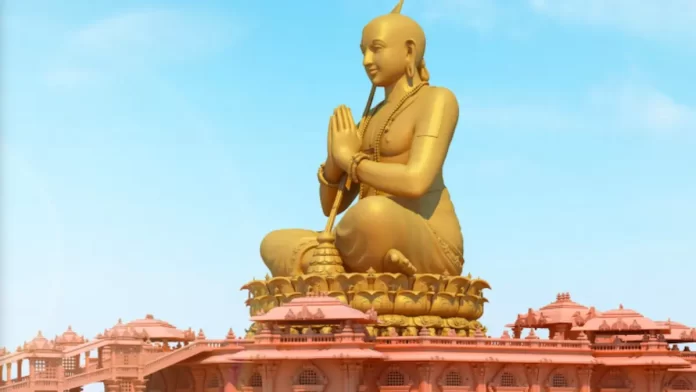On Monday Prime Minister Narendra Modi inaugurated a giant statue of Sri Ramanujacharya in Hyderabad. The statue termed the “Statue of Equality” is among one of the tallest metallic statues in sitting position, in the world.
“If Sardar Sahib’s Statue of Unity is repeating the oath of unity in the country, then Ramanujacharya’s Statue of Equality is giving the message of equality. This is the specialty of India as a nation”, the PM said.
The 216-feet tall Statue is made of “panchaloha”, a combination of five metals gold, silver, copper, brass, and zinc.
Who was Ramanujacharya?
Ramanuja or Ramanujacharya was a Brahmin philosopher, theologian, and social reformer from Tamil Nadu. He was one of the most important exponents of the Sri Vaishnavism tradition within Hindu-Brahmanism.
Ramanujacharya also contributed to the philosophical foundations for the Bhakti movement.
Interestingly, however, unlike the Bhakti movement saints who chose vernacular languages to communicate to common people, Ramanujacharya wrote most of his influential texts in Sanskrit.
What is Vishishtadvaita Philosophy?
Vishishtadvaita is one of the three subschools of the Vedanta philosophy of Hindu-Brahmanism. According to Vishishtadvaita, God alone is the supreme reality but is characterized by multiplicity and different attributes.
In other words, it believes in all diversity subsuming to an underlying unity.
In English, the term Vishishtadvaita means a unique non-dualism or qualified monism. It became the basis of Ramanujacharya’s philosophical discourses.
Vishishtadvaita and other schools of Vedanta Philosophy
Vishishtadvaita stands in opposition to the other two subschools of Vedanta namely Adi Shankaracharya’s Advaita or absolute monism and Madhvacharya’s Dvaita or dualism.
Adi Shankaracharya’s Advaita or non-dualistic philosophy propounds that there is no fundamental difference between Atman (individual soul) and God.
Madhvacharya’s Dvaita or dualistic philosophy on the other hand argues that there lies a fundamental difference between Atman (individual soul) and Brahman or (Supreme Almighty).
Whereas Shankaracharya’s Advaita or non-dualistic philosophy is closer to the Sufi concept of “wahdat-al-wajood”, Ramanujacharya’s Vishishtadvaita and Madhvacharya’s Dvaita or dualistic philosophy is closer to the traditional Islamic view that the creator Almighty and the created ones are not the same.
Key principles of Vishishtadvaita
The three key principles of Vishishtadvaita are Tattva, Hita, and Prapatti.
Tattva
Tattva signifies the quest for the knowledge of the 3 real entities namely, Jiva i.e. living or sentient beings, Ajiva i.e. the non-living beings, and Ishvara i.e. the Supreme-self and the cause of all manifestations and in-dwelling giver of grace based on Karma.
Hita
Hita signifies the means of realization of the supreme Godhead. According to the Vishishtadvaita philosophy, one can attain Godhead by means of bhakti or devotion and Prapatti or total self-surrender to the supreme Almighty.
Purushartha
Purushartha connotes the real goal of life to be attained. According to the Vishishtadvaita philosophy, it is the moksha or liberation from the bondage of life, birth, and death.
Also Read| Significance of Ramanujacharya in today’s Context
